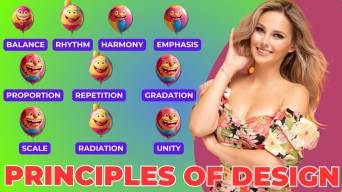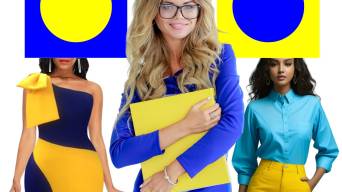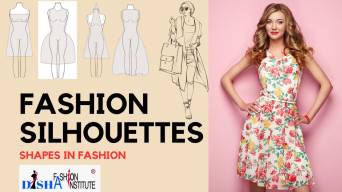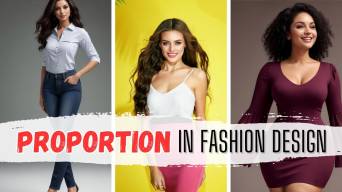Proportion in Fashion Design
Proportion is the silent architect of fashion; it gives life and rhythm to a design, allowing it to speak to the soul.
Alexander McQueen
In this blog post, let’s explore the transformative power of proportion, revealing how it elevates fashion into a symphony of style and personal expression.
Table of Content
- What is Proportion in Fashion Design?
- Proportion in Fashion Design: The Art of Comparing and Harmonizing Elements
- Equal Proportion & Unequal Proportion in Fashion Design
- Golden Mean or Golden Ratio of Proportion?
- The Rule of Third for Garments Proportion
- Break All Rules
- What is a Well-Proportioned Garment?
- Body Proportion in Fashion
- Garment proportions
- Accessory Proportions
- Visual interest
- Personal Style
- Conclusion
- All Topics on Principles of Design in Fashion
- All Topics on Elements of Design in Fashion
- Explore Free Courses
- Join Fashion Designing Course
What is Proportion in Fashion Design?

Proportion in fashion design refers to the comparative relationships between distances, sizes, amounts, degrees, and parts within a garment or an outfit. It involves understanding how different elements of the design relate to each other and the overall composition. These elements can be one-dimensional lines, two-dimensional shapes, or three-dimensional forms. Proportion is not solely about the size of individual parts but how they harmonize with each other to create a balanced and aesthetically pleasing whole.
Proportion in Fashion Design: The Art of Comparing and Harmonizing Elements

The concept of proportion in fashion design is based on the idea of comparison or "in relation to" something else. Simply put, it's about how different parts of a design interact with one another. Even if a single part of a garment, say a sleeve, appears to be well-proportioned independently, if its size or shape doesn't complement the rest of the outfit, the entire ensemble may still seem "out of proportion."
Proportion goes beyond just bringing elements together; it also invites exploration of how individual parts contribute to the overall appeal. It raises questions about what makes proportions visually pleasing or unappealing. Cultural preferences may influence ideas of beauty and ugliness, but some general guidelines have stood the test of time and are appreciated in various cultures.
For instance, imagine a dress with an overly large sleeve that dominates the rest of the dress. In this case, the dress is considered "out of proportion" or disproportionate because the sleeve overwhelms the balance of the entire design. Conversely, if a part of an outfit, like a collar or a pocket, is too small compared to the rest of the garment, it may also be considered disproportionate.


Equal Proportion & Unequal Proportion in Fashion Design
In fashion design, proportion is a critical factor that greatly influences how a garment looks and feels to the eyes. When a design is balanced and well-proportioned, it creates a sense of harmony and beauty. Good designs are meant to be visually pleasing and balanced.
Many mathematicians and designers have developed guidelines to achieve a harmonious and pleasing design with unequal proportions. One such popular concept, known as the "Golden Mean" or "Golden Ratio," was introduced by Greek mathematicians.
Golden Mean or Golden Ratio of Proportion?

The Golden Ratio is a unique mathematical number, approximately equal to 1.618. This ratio is derived from the Fibonacci sequence, which is a naturally occurring sequence of numbers found in various aspects of the world, such as the number of leaves on a tree or the shape of a seashell.
How is Golden Ratio Related to Fashion Design?

Source of Golden Ratio
As stated earlier golden rule has been derived from the Fibonacci series. The Fibonacci sequence is a series of numbers where each number is the sum of the two numbers that come before it. It starts with 0, 1, 1, 2, 3, 5, 8, 13, 21, and continues infinitely. Take a close look at the sequence. Except for the first 4 numbers, if you consider any two adjacent numbers, e.g. 3, 5 or 5, 8 or 8, 13 or 13, 21 or 21, 34 and so on, you will see dividing the latter number by the former gives you a number very near to 1.618, i.e. 5/3 or 8/5 or 13/8 or 21/13 or 34/21 all these are approximate equals to 1.618.
Example Application of the Golden Ratio in Fashion Design
The golden mean or golden ratio is the proportion rule that pleases the eyes. The Golden ratio has been widely applied in art, architecture, and design for centuries due to its aesthetically pleasing and harmonious properties. In fashion, the golden mean or golden ratio is used to achieve balanced and visually appealing proportions in clothing and accessories.



Most Flattering Hemline For You
Another formula to remember for the Golden Ratio applies to fashion design.
Using the above formula, you can find out your own golden number. How? Very simple.

The Rule of Third for Garments Proportion
The rule of thirds is a simplified version of the more complex golden ratio, which can sometimes be challenging to implement. In contrast, the rule of thirds offers a straightforward approach. It involves dividing a garment into three equal sections. According to this rule, if the top section occupies one-third of the total size, the bottom section should take up the remaining two-thirds. This guideline is relevant in fashion design for achieving proportion and is applied in various other creative fields such as architecture, photography, and art.

For example, consider the iconic Eiffel Tower. Its design adheres to the rule of thirds. By vertically dividing the tower into three equal sections, each section has a harmonious relationship with the others. This principle enhances the tower's visual appeal and makes it more engaging to the viewer's eye.
In essence, the rule of thirds simplifies proportion in fashion design, making it more accessible and achievable while also contributing to the visual harmony and balance that can be found in various forms of creative expression.
Break All Rules
In today's fashion world, things are changing a lot. The old rules like the golden ratio and the rule of thirds aren't the only options anymore. These traditional proportions might not always be trendy now. Styles that are intentionally "out-of-proportion" are pretty popular. Fashion keeps switching between classic and new and between ordinary and unusual. That's why we shouldn't think of the golden ratio or the rule of thirds as strict rules. They're more like general guidelines that try to make things look pleasant to our eyes.
What is a Well-Proportioned Garment?
A well-proportioned garment is designed and tailored in a way that flatters the wearer's body shape, creates a balanced silhouette, and enhances the overall elegance of the outfit. It means that the different elements of the garment, such as the length, width, volume, and design details, are carefully taken and balanced to achieve a visually pleasing and harmonious look. Generally, formal garments for both men and women are made considering the well-proportion that enhances the wearer’s look while maintaining subtlety.
Sometimes, a single part of a body may seem “well proportioned”, but if its size or shape is inconsistent with the rest of the figure, the whole figure still seems “out of proportion”.
The most beautiful application of proportion in fashion design seems to have a slight deviation in a garment. The most pleasing proportions are those garments that are unequal. For example, a huge puffed sleeve can overwhelm the rest of the part of the dress. In that case, we can say the garment is “out of proportion”.
Again, a garment made in symmetrical balance can be said to be “well proportioned”.
Few important aspects of proportionsin fashion design.
Body Proportion in Fashion
Proportion starts with the body itself. Garments should be designed to flatter the natural curves and lines of the human body. If a garment fits well and follows the body’s proportions, it enhances the wearer’s figure making them more attractive and confident. So when designing clothing, it’s important to consider the proportions of the body as a whole. Some key proportions to consider are the ratio of the torso to the legs and the width of the shoulders to the hips. Besides, fashion designers also consider the proportions of specific body parts, such as the bust, waist and hip.
A correctly proportioned garment can create the illusion of height and slimness for petite or curvier individuals. For example, vertical lines and elongated shapes can make a person appear taller, while dark-coloured, streamlined silhouettes can create a slimming look.
Again, using high-waisted pants or skirts can elongate the legs, while a peplum top can add volume to the hips and create an hourglass shape.
(high waist jeans) v/s (low-waist jeans)
Understanding proportions and balance can help the designer to create a suitable garment for the client.
Garment proportions
The proportions of the garment itself should be visually balanced. For example, a dress with a fitted top and a flared skirt should have the appropriate balance between the two.
But, an oversized top with oversized baggy trousers can create a hideous and out-of-proportion look.
A sweater that is excessively large for the wearer can overwhelm the body and create a sloppy, unflattering look.
A wearer should consider his/ her garments while pairing. For example, a cropped top is very trendy these days, but combining this cropped top with low-rise jeans can lead to an imbalanced silhouette, exposing too much midriff and making the legs appear shorter.
v/s
The wearer should also consider his/her body proportion while choosing a garment. For example, Off-the-shoulder tops can draw attention to broad shoulders, making them appear wider and may create a manly figure.
Accessory Proportions
Accessories, such as jewellery and handbags, should also be proportional to the garment and the body because these are very important components of an overall look. Accessory proportion refers to the relative size, scale, and placement of accessories within an outfit. Remember, accessories that are too small or too large in proportion to the clothing can throw off the balance of the look and detract from the overall effect. For example, a small clutch purse may look out of proportion with a large, voluminous ball gown.
Well-proportioned jewellery can elevate an outfit, adding a touch of elegance and sophistication. So, the right jewellery choice is necessary to enhance the overall look, drawing attention to specific areas or features, such as the neckline, wrists, or fingers.
Again, one should remember that jewellery proportion helps in achieving balance and harmony within an outfit. It should be in proportion to the wearer’s body size and the scale of the clothing. For example, delicate jewellery may suit a petite frame, but the bolder pieces can work well with larger body frames.
Remember well-proportioned accessories can elevate even the simplest outfits, transforming them into stylish and polished looks. Jewellery and accessories have the power to add personality and flair to an otherwise basic ensemble. They should complement the clothing in terms of colour, texture, and style. They should not overpower the outfit but rather enhance and harmonize with it.
Visual interest
Proportion can also be used to create visual interest in a design. Visual interest refers to the use of design elements such as colour, texture, pattern, and shape to create an appealing and attention-grabbing look. This can help a design stand out in a crowded fashion market and make a lasting impression on viewers. For example, adding a focal point like an oversized bow on a dress can create a visually interesting contrast with the rest of the garment yet pleasing to the eye.
Using visual interest strategically can grab the viewer’s eye to certain parts of the wearer's body. For example, a statement belt can accentuate the waist.
Personal Style
Proportion can also be used to create a particular personal style. This personal style is a very important aspect of fashion design, as it helps a designer create unique and authentic designs that reflect their own aesthetic and vision. This style is largely influenced by the designer's cultural background, personal experience, personality and creative influences. For example, some designers may create designs with exaggerated proportions, such as extremely long sleeves or oversized collars.
Conclusion
So proportion is an important principle of fashion design that ensures that each element of a garment is visually balanced and harmonious with the other elements. By understanding the different aspects of proportion in fashion design, designers can create unique and visually interesting designs that flatter the body and are both functional and aesthetically pleasing. Mastering this principle is akin to wielding a magical wand, allowing designers to flatter body shapes, draw attention to focal points, and communicate unique narratives through their creations. Valentino Garavani, the famous Italian designer truly said
Proportion is the dance of shapes, the balance of volumes - it unlocks the door to a world where fashion transcends trends and becomes timeless art.
Valentino GaravaniAll Topics on Principles of Design in Fashion
To explore all topics on principles of design in fashion, browse the list of blog posts below and click on the relevant heading to access the articles.

Principles of Design in Fashion
11 Principles of Design in Fashion You Need to Know to Become a Fashion Designer

How to Contrast Colors for Clothing
How to Contrast Colors for Clothing | 8 Ways to Create Colour Contrast in Fashion
All Topics on Elements of Design in Fashion
To delve into all the subjects about elements of design in fashion, simply navigate through the list of blog posts below. Click on the headings to access the articles you're interested in reading.

Elements of Design Line in Fashion
Elements of Design | Lines in Fashion | Creating Optical Illusions With Lines

Color Psychology in Fashion Design
Impact of Color Psychology on Fashion Design: Exploring 12 Transformative Role of Color

Elements of Design in Fashion
7 Elements of Design in Fashion You Must Understand as a Fashion Designer

Types of Silhouettes in Fashion
Types of Silhouettes in Fashion | 12 Different Types of Fashion Silhouettes Explained
Explore Free Courses
Begin your fashion journey with our free fashion design foundation course. Dive into the world of style and creation today!
Fashion Designing Foundation Course
Join Fashion Designing Course
Enrol in our certificate courses for fashion designing and textile designing






Comments